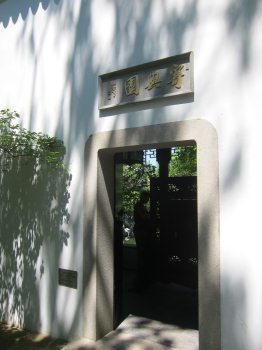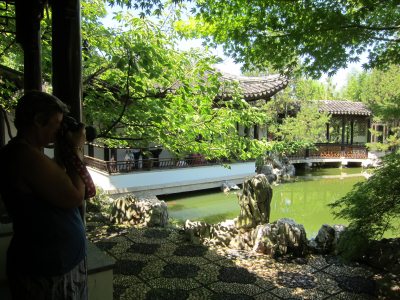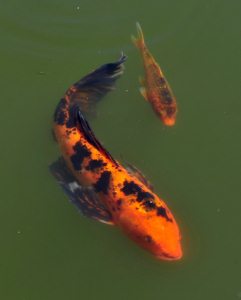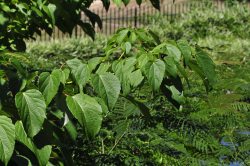Chinese Scholar's Garden

|
The New York Chinese Scholar's Garden
To be able to say we had visited all the boroughs of New York City we went on the Staten Island Ferry with a plan to wander around the botanical gardens. We got off the free ferry and found the bus to take us to the Snug Harbor Cultural Center entrance. We had read that there was a Chinese Scholar's Garden within the Staten Island Botanical Garden and expected crowds considering the amount of passengers on the ferry, but we were the only two who got off the bus and walked through the gates. The entrance and gift shop for the Scholar's Garden is located in one of the landmarked Second Empire Victorian Cottages on Cottage Row. Before midday on a Tuesday the entrance is free, bargain.
Design: The garden is designed with "ya", or elegance. The
garden is traditionally entered through a narrow passage where meditation
takes place, prior to entering the main garden. The design of the garden
produces harmony through its views and concepts. The garden creates an infinite
space within an enclosed area. ·
The borrowed view extends space beyond the border of the
garden. ·
The hidden view creates suspense and excitement as one moves
deeper into the garden. · The opposite view is framed by a moon gate or floral window.
The garden materials were shipped to Staten Island in the spring of 1998 and the garden opened in June 1999. A team of 40 Chinese artists and artisans from Suzhou constructed the garden. The president of the botanical garden, Frances Paulo Huber, recognized the need for an authentic Chinese garden in 1984. The garden was finally constructed with the support of many partners, including the Staten Island Botanical Garden, the City of New York, the Landscape Architecture Company of China, the Metropolitan Chinese American Community, various private foundations, and hundreds of individuals and corporate donors. After a long series of collaborations a contract was signed with the Landscape Architecture Corporation of China. Mr. Zou Gongwu was appointed as chief project designer.
Chinese gardens go back almost two thousand years to the Han Dynasty though most Scholar's gardens date back to the more recent Ming and Qing Dynasties. A Scholar's Garden would have been built by a scholar or an administrator retiring from the Emperor's Court. It would have been an enclosed private garden always associated with a house which, in turn without it's garden would not have been considered whole.
Elements: ·
Wood - Nails or glue are not used in a Chinese garden. Wooden elements are
joined together using traditional Chinese construction
techniques. ·
Rocks - In Chinese literature, rocks are described as the "bones of the
earth." We were told to compare the black and white cobbles with our bare feet,
the black were hotter than the white. ·
Water - The garden contains three ponds and one waterfall. Water is thought
of as the arteries of the world. ·
Plantings - China gave the rose, lilac, daphne, species of rhododendron and
the peony to the rest of the world. Trees, shrubs and flowers are selected for
shape, seasonal character and symbolic meaning. ·
Furniture - The furniture of the garden is called the "internal
organs." ·
Walls - Walls are strategically placed in the garden for design
purposes. ·
Walkways - The curvature of the walkways offer many views and
angles. ·
Pavilions - There are two pavilion in the garden. One is for the scholar's study
and the other provides visual access to various other
scenes. ·
Xie - A Xie is a building one half hovering over a lake. The designs make
it seem that the building is floating in the water. ·
Bridge - Bridges are often curvy, providing visitors a better view of the
surroundings. · Painting and Calligraphy - Paintings and calligraphy represent the garden owner's knowledge of literature and art.
ALL IN ALL A BEAUTIFUL LITTLE PLACE AMAZING TO SEE A FISH WITH CHINESE WRITING ON HIS HEAD Have you ever seen Pepe with a greater need to hurt Big Bear - nearest thing to hand - a rose Have you ever seen anyone use a rose stem like a machete - Bear has Run Bear, Run
|





















































